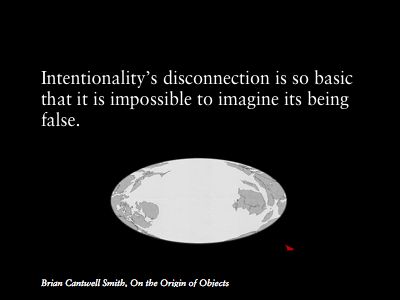
I said that I like to read sci-fi and philosophy in the course of my work. It’s good to kind of float off and absorb everything, then use the abstractions as giant metaphors to move ideas in different directions. Whatever. It’s fun. I’m reading some metaphysics at the moment and I just came across a phrase which talks about this grasp/reach stuff and you could really call it sci-fi too.
On the Origin of Objects, by Brian Cantwell Smith, is about where the quality of objecthood actually originates. Like, if something is “red” we can argue about whether the quality of red is in my head, or the nature of visible light, or the molecular electron surfaces, or whatever mix. We can argue about where the “object” label comes from too. In this section, he’s talking about semantic reach and grasp. Remember: Reach is what you can see. Grasp is what you can affect. The semantic bit is because he’s discussing how we refer to things.
This is the lead-in:
“consider laser beams. They reach a long way too—to the moon and back, for example, allowing us to measure precisely how far away the moon is. [… but these] do not hold a candle to reference. With a few simple syllables we can reach backwards in time, against the flow of causality, to the Pharaohs of Egypt. Or reach forward, to things that have not yet happened, such as the election of the first female US president. […] Reference travels at the speed of logic.”
Nice. Now this is the bit I like. He poses a counterfactual and sets up a little conceit worthy of the most hardcore sci-fi:
“Not even the National Security Agency, with all the money in the world, could build a meter to register when the control room of Cheyenne Mountain was the subject matter of a terrorist’s intentional act. Indeed, intentionality’s disconnection is so basic that it is impossible to imagine its being false. […] Hypotheticals would be impossible; fantasy lives would be banned.”
This is it: “You could not even think about continental drift without dragging the tectonic plates along with you.”
Yum.
The illustration is an animation of the movement of Earth’s tectonic plates over the past half billion years.
What does all this matter? It gives us new ideas. Imagine you could change your face depending on who looked at you.
If you did that, other people would try to see your real face, by looking more carefully, with a lighter touch. You’d get better at detecting. There would be an arms race.